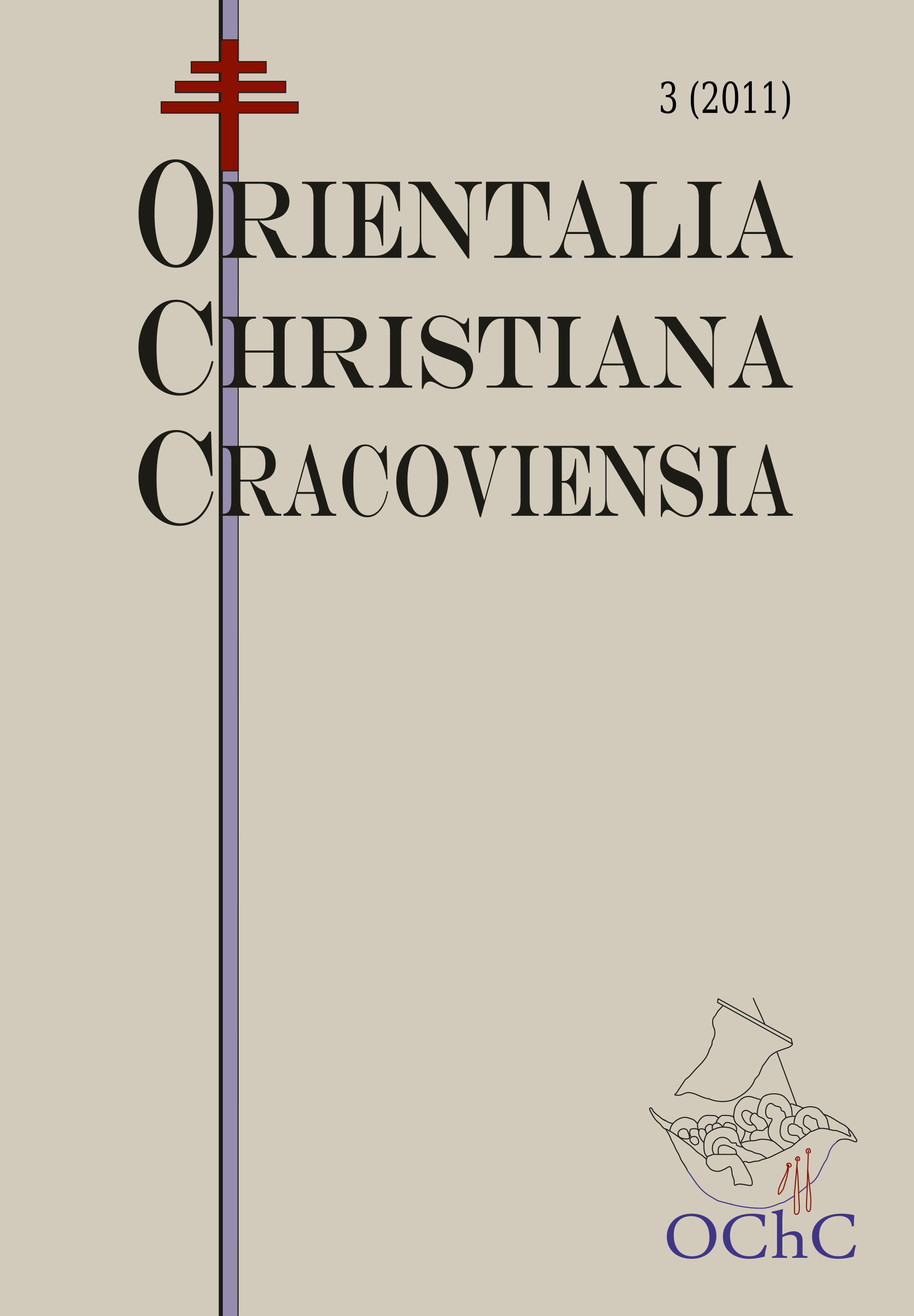Syriac Heritage of the Saint Thomas Christians: Language and Liturgical Tradition Saint Thomas Christians – origins, language and liturgy
DOI:
https://doi.org/10.15633/ochc.1038Słowa kluczowe:
India, Syriac Christianity, Saint Thomas Christians, malayalamAbstrakt
According to the anonymous Syriac apocryphal Acts of Thomas from the first half of the 3rd century, the apostolic mission to India began during the first half of the first century CE. Thomas the Apostle himself is supposed to bring the Gospel to India’s king and eventually to die as a martyr in South India near Madras. As mentioned in the Indian tradition, St Thomas did not travel directly to Madras but made landfall in the coastal region of Kerala. The historical sources mentioned the existence of an ancient group of Christians from Kerala, traditionally called Saint Thomas Christians, since the end of the 2nd century. We have no detailed information about Christianity in Kerala in the first three centuries. One could only speculate what language was used in prayers (most probably Aramaic, and later Syriac), what the early liturgy looked like (doubtless similar to the early Christian one).
Bibliografia
Apocryphal Acts of the Apostles, Edited from Syriac Manuscripts in the British Museum and Other Libraries by W. Wright. Vol. I. The Syriac Texts. Vol. II. The English Translation, Piscataway, New Jersey 2005.
Asher R. E., Kumari T. C., Malayalam, London - New York 1997.
Atiya A. S., A History of Eastern Christianity, London 1968.
Atiya A. S., Historia Kościołów wschodnich, Warszawa 1978.
Babu Paul D., The Syrian Orthodox Christians of St. Thomas, Cochin 1986. Baron A., Pietras H. SJ, Synody i Kolekcje Praw, vol. IV, Źródła Myśli Teologicznej, Kraków 2010.
Baum W., Winkler D. W., The Church of the East. A concise history, London - New York 2003.
Baumer C., The Church of the East. An Illustrated History of Assyrian Christianity, London -New York 2008.
Brock S., An Introduction to Syriac Studies [in:] J. H. Eaton, ed., Horizons in Semitic Studies: Articles for the Student, University Semitics Study Aids 8, Birmingham 1980.
The Centenary of the Malayalam Bible
(http://www.keralabrethren.net/boardkb/view.asp?id=2119&forum=General).
Exhibition traces evolution of Malayalam Bible, “The Hindu” (http://www.hindu.com/2011/06/15/stories/2011061550740200.htm).
Frohnmeyer L. J., A Progressive Grammar of the Malayalam Language. Second edition, revised, New Delhi 2004 (originally published in 1913).
Lexicon to the Syriac New Testament (Peshiṭta), with copious references, dictions, names of persons and places and some various readings found in the Curetonian, Sinaitic palimpsest, Philoxenian & other MSS by William Jennings, M. A. Revised by Ulric Gantillon, M. A., Ancient Language Resources, Ancient Language Resources, Eugene, Oregon 2001.
Martimort A. G., Dalmais I. H., Gy P.-M., Jounel P., The Church at Prayer: Principles of the Liturgy, Collegeville, Minnesota 1987.
Moag R. F., Malayalam. A University Course and Reference Grammar, Ann Arbor 1980.
Nadolski B. SJ, Liturgika. Vol. 1: Liturgika fundamentalna, Poznań 1989. Vol. 2: Liturgia i czas, Poznań 1991. Vol 3: Sakramenty, sakramentalia, błogosławieństwa, Poznań 1992. Vol. 4: Eucharystia, Poznań 1992.
Nariculam A., Syro-Malabar Liturgy (http://mangalapuzha.wordpress.com/2009/08/28/syro-malabar-liturgy/); K. P. M. Basheer, A sacred language is vanishing from State (http://www.thehindu.com/2008/08/11/stories/2008081164350500.htm).
A new venture in Bible mission in Kerala, Kerala Catholic Bible Society (http://www.keralabiblesociety.com/pages/en/BibleCommission.html).
Nöldeke Th., Compendious Syriac Grammar, Winona Lake, Indiana 2001.
Ordo Baptismi adultorum juxta ritum Ecclesiae Malabaricae Chaldaeorum, Rome 1859.
Ordo Chaldaicus ministerii Sacramentorum Sanctorum, Rome 1775.
Ordo Chaldaicus Missae Beatorum Apostolorum, juxta ritum Ecclesiae Malabaricae, Rome 1774.
Ordo Chaldaicus Rituum et Lectionum, Rome 1775.
Paradigmen, Literatur, Chrestomathie und Glossar, Leipzig 1981.Pigulewska N. W., Kultura syryjska we wczesnym średniowieczu ,Warszawa 1989.Poomangalam C. A, The Antiquities of the Knanaya Syrian Christians, Kerala 1998.
Sokoloff M., A Syriac Lexicon. A Translation from the Latin, Correction, Expansion, and Update of C. Brockelmann’s Lexicon Syriacum, Piscataway, New Jersey 2009.
Thesaurus Syriacus. Collegerunt: Stephanus M. Quatremere, Georgius Henricus Bernstein, G. W. Lorsbach, Albertus Jac. Arnoldi, Carolus M. Agrell, F. Field, Aemilius Roediger. Auxit, digessit, exposuit, edidit: R. Payne Smith, S.T.P., Tomus I: ܐ ܒ ܓ ܕ ܗ ܘ ܙ ܚ ܛ ܝ ܟ ܟܟ. Oxonii. E typographeo Clarendoniano M.DCCC.LXXIX. Tomus II: ܠ ܡ ܢ ܣ ܥ ܦ ܨ ܩ ܪ ܫ ܬ. Oxonii. E typographeo Clarendoniano M.DCCCC.I.
Vellian J., Knanite community: History and culture, Syrian Church Series, vol. XVII, Kottayam 2001.
Vellian J., Marriage Customs of the Knanites, Christian Orient, 9, Kottayam 1988.
Zacharias T., An English-Malayalam Dictionary ഇംഗ്ളീഷ് മലയാളം ശബ്ദകോശം iṁgḷīṣ malayāḷaṁ śabdakōśaṁ, Mangalore 1907.
Pobrania
Opublikowane
Numer
Dział
Licencja
Twórca oświadcza, że przysługują mu prawa autorskie do utworu i że nie są ograniczone w zakresie objętym niniejszym oświadczeniem oraz że utwór jest dziełem oryginalnym i nie narusza praw autorskich innych osób.
Twórca zezwala Uniwersytetowi Papieskiemu Jana Pawła II w Krakowie na nieodpłatne, niewyłączne i nieograniczone w czasie korzystanie z utworu, to jest:
- utrwalanie i zwielokrotnianie: wytwarzanie egzemplarzy utworu techniką drukarską, reprograficzną, zapisu magnetycznego oraz techniką cyfrową;
- obrotu oryginałem albo egzemplarzami, na których utwór utrwalono (wprowadzanie do obrotu, użyczenie lub najem oryginału albo egzemplarzy, publiczne wystawienie, wyświetlenie, a także publiczne udostępnianie utworu w taki sposób, aby każdy mógł mieć do niego dostęp w miejscu i w czasie przez siebie wybranym);
- włączenie utworu w skład utworu zbiorowego;
- udzielanie przez Uniwersytet Papieski Jana Pawła II w Krakowie sublicencji Creative Commons Uznanie autorstwa-Użycie niekomercyjne-Bez utworów zależnych 3.0 Polska
Uniwersytet Papieski Jana Pawła II w Krakowie udostępnia utwór na Platformie Czasopism należącej do uczelni, na licencji Creative Commons Uznanie autorstwa-Użycie niekomercyjne-Bez utworów zależnych 3.0 Polska. Tym samym uprawnia wszystkich zainteresowanych do korzystania z utworu pod następującymi warunkami:
- zostanie podany autor i tytuł utworu,
- zostanie podane miejsce publikacji (tytuł czasopisma i adres internetowy do oryginalnie opublikowanego utworu),
- utwór będzie dystrybuowany w sposób niekomercyjny,
- nie będą tworzone utwory zależne.

